In today’s changing consumer buying world, online reviews have become a pivotal source of information for potential buyers, often holding more sway than the most compelling marketing narratives.
Our 2023 State of B2C Online Reviews survey shows that most people trust reviews from other customers more than ads from the brand.
However, this trust is not absolute, as the prevalence of inauthentic and fake reviews continues to cast shadows of doubt, causing consumers to approach reviews with a measure of skepticism. This dichotomy presents a nuanced challenge for businesses and review platforms as they navigate the delicate balance of fostering trust and ensuring the authenticity and reliability of user-generated content in an era marked by information overload and skepticism.
Why survey B2C consumers on B2B SaaS Reviews?
Even though our site usually focuses on B2B software, looking at customer reviews in the B2C world can teach us a lot. That’s why we’ve put together the 2023 State of B2C Online Reviews report.
By learning how everyday shoppers see and use reviews, we can see how it’s different or similar to what business software buyers told us in our 2023 State of B2B Software Reviews survey.
For the 2023 State of B2C Online Reviews report, we surveyed 276 US consumers aged 21-59 using one of these three review sites in the last 30 days: Angi, ConsumerAffairs, or Yelp.
We asked them why they use review sites, how they use them, and what holds them back from using them more.
6 findings stood out from the review site users’ answers.
Table of Contents
Key Findings
Let’s have a closer look at these six findings about online reviews:
82% of review site users said reviews are more influential than vendor marketing and sales claims

Thought-Provoking Takeaway 💡
This finding underscores the growing skepticism towards traditional marketing and sales messages in an age where information is readily available, and consumers are empowered like never before. It reflects a significant shift in consumer behaviour that many know – a preference for authentic, peer-driven insights over marketing claims.
Actionable Takeaways 🎬
Businesses should not only recognize the influence of the voice of their customers but also invest in amplifying it.
Companies should:
- Engage with customers to encourage them to share their experiences.
- Address both positive and negative feedback, showcasing a commitment to improvement.
- Integrate customer testimonials and review site accomplishments into marketing campaigns to lend authenticity to their messaging.
- Build a solid online reputation by hiring Customer Marketing and Advocacy (CMA) professionals and valuing customer input as a cornerstone of business growth.
By aligning their strategies with the preferences of today’s discerning consumers, businesses can foster trust, credibility, and lasting customer loyalty.
98% of review site users said that the average rating on the 5-star scale is important
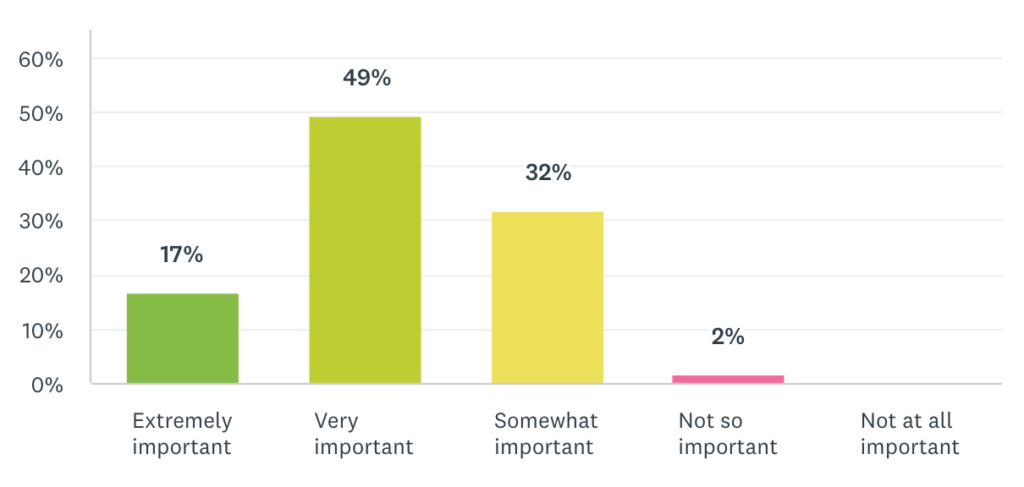
A staggering 98% of consumers who use review sites attributed importance to the average rating on a 5-star scale.
Even more intriguing is that 66% of those surveyed classified the average rating as “very important” or “extremely important.”
These figures align with the Yotpo 2022 Reviews Consumer Survey data, where nearly 56% of consumers reported that star ratings played a very important role in their decision-making, while 41% considered them somewhat important.
Thought-Provoking Takeaway 💡
This overwhelming emphasis on the average rating underscores the critical role that perception and reputation play in decision-making processes. In a world inundated with choices, consumers rely on these ratings as a quick and accessible metric to guide their choices. The data suggests that aligning efforts to enhance average ratings can create a competitive advantage with today’s discerning and informed buyers.
Actionable Takeaways 🎬
Recognizing the weight that consumers assign to average ratings presents a unique opportunity for businesses to prioritize their reputation management strategies. Companies should monitor their ratings across the web and focus on improving lower ratings by asking for more reviews.
Additionally, proactive engagement with customer feedback can help address concerns and showcase a commitment to improvement, ultimately bolstering the trustworthiness of the ratings.
#1 issue with reviews is a lack of authenticity
In an era of information overload, the crisis of trust looms large.
While most consumers trust reviews more than marketing and sales messages, there’s still a limit to the trust they have online reviews. Consumers who use review sites would use them more if they found the reviews are more authentic.
61% of respondents who use review sites said the “authenticity of the review content” is an issue that limits their use of them.
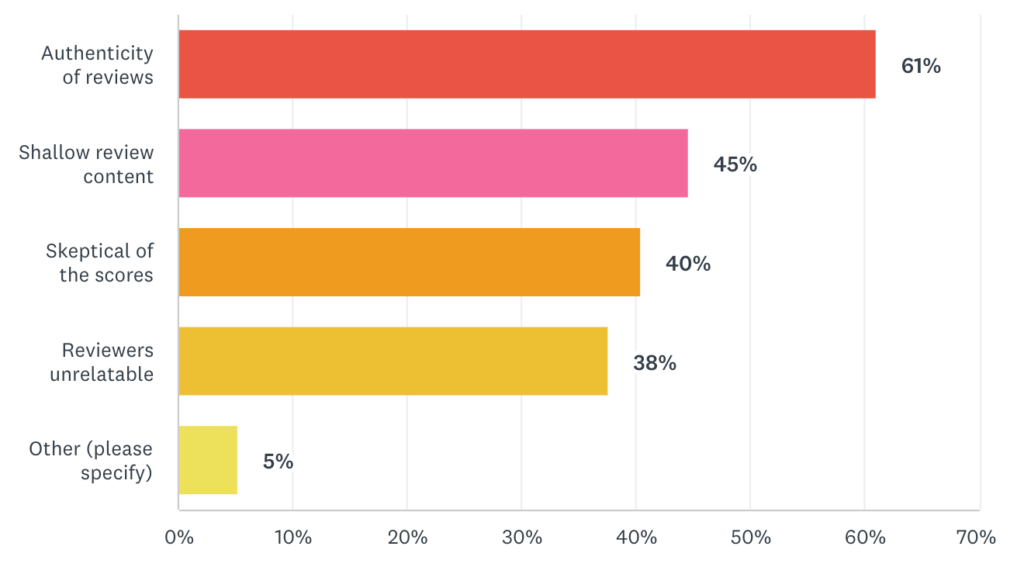
32% of respondents who don’t use review sites said it’s because “I don’t trust the authenticity of the review content.” Also, 24% of consumers are skeptical of review ratings (scores).
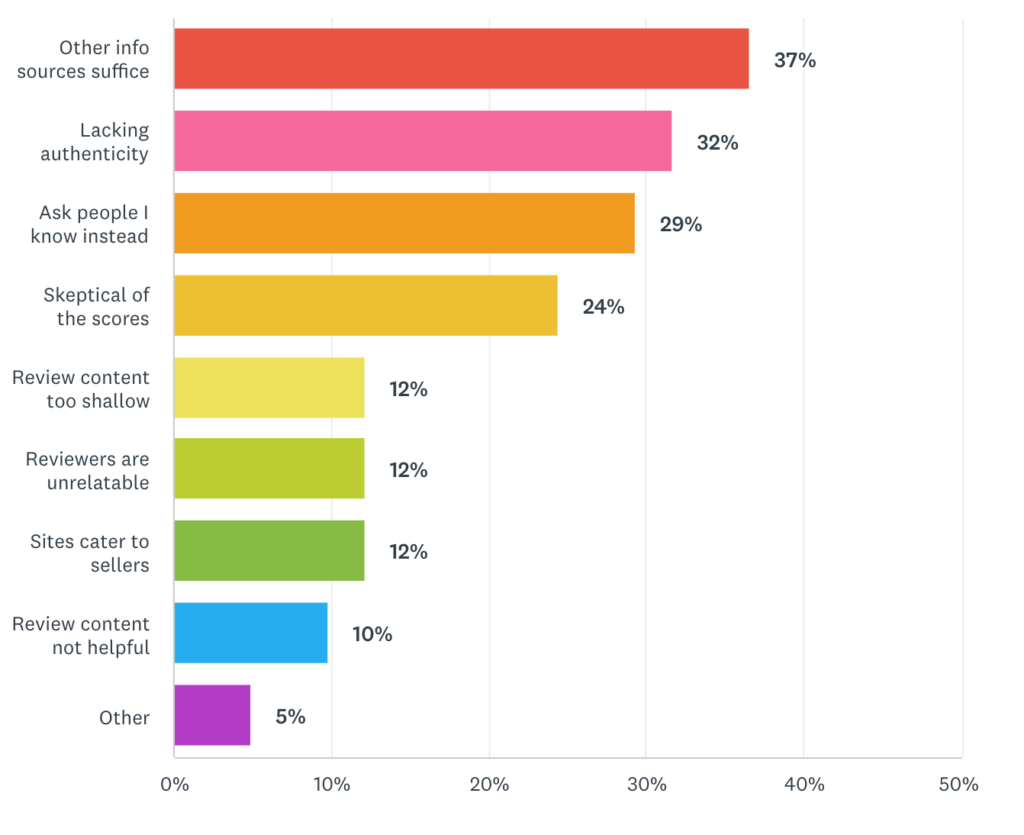
Thought-Provoking Takeaway 💡
In an increasingly digital world, the erosion of trust in online information is a pressing issue. The prevalence of skepticism towards review content highlights the need for platforms to implement more rigorous measures to verify and validate reviews.
This finding challenges review platforms to stamp out fake reviews and limit businesses gaming the system to maintain consumer trust in online reviews.
Actionable Takeaways 🎬
Implement Stringent Verification: Review sites that don’t have a mechanism to verify the identity of reviewers and the legitimacy of their experiences should do so. Verified purchase badges, authenticated user profiles, or requiring detailed explanations can enhance trust and encourage honest reviews. This proactive approach can alleviate concerns and promote confidence in review content.
77% of review site users do so to avoid choosing a bad product or service
The top 5 reasons why consumers read online reviews on review sites like Yelp, Angi (Angie’s List), and ConsumerAffairs are:
- Avoid choosing a bad product or service (77%)
- Make informed purchases (74%)
- Get an Idea of what to expect if I buy (62%)
- Learn the pros and cons of what I’m considering (61%)
- Hear from other buyers who I trust more than vendors/sellers (54%)
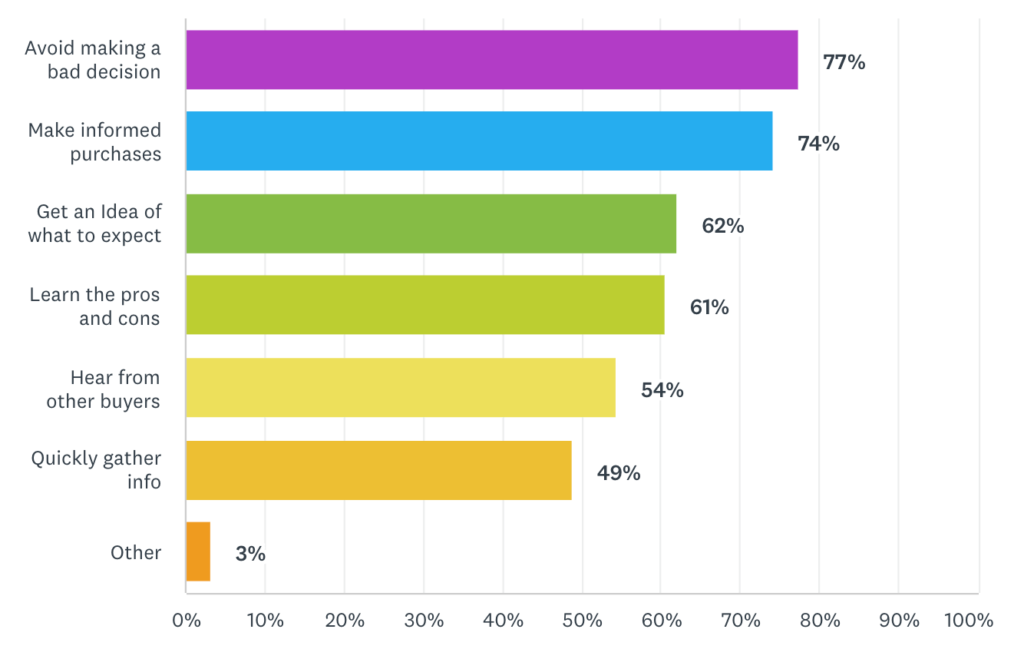
Thought-Provoking Takeaway 💡
These results reflect a growing consumer emphasis on informed decision-making in the digital age. In an era saturated with choices, consumers prioritize avoiding poor decisions, understanding the full scope of their potential purchases, and learning from others’ experiences. This trend highlights the shift from consumers relying on limited sources and amounts of information to a more informed and research-driven online approach.
Actionable Takeaways 🎬.
For Businesses:
Leverage Social Proof: Highlight positive reviews and testimonials to showcase the satisfaction of previous customers. Positive feedback can be social proof, influencing potential buyers’ decision-making process. Consider framing your review-related messages as loss and risk avoidance to appeal to the 77% of consumers who read reviews to “avoid choosing a bad product or service.”
Transparency is crucial: Businesses should embrace transparency by providing accurate and detailed information about their products or services. With 61% of consumers looking to learn the pros and cons of a product or service, addressing both strengths and weaknesses can build trust and attract more customers.
Engage with Reviews: Actively engaging with customer reviews, both positive and negative, demonstrates a commitment to improving and meeting customer needs. Responding to concerns and feedback can mitigate potential negative impacts on reputation.
For Consumers:
Filter for 1, 2, and 3-star reviews: For the 77% of consumers reading reviews to avoid choosing a bad product or service, filter out the 4 and 5-star reviews. This filter will help hone in on the critical reviews that shed light on the issues with the product or service. Further, hone in on 2 and 3-star reviews to dive deeper into the critical reviews that have more balance than the often emotionally charged 1-star reviews.
Look for reviewers “in your shoes”: Consider how each product or service aligns with your needs and preferences while reading reviews. Not every negative review might be relevant to your situation, so focus on aspects that matter most to you.
Contribute to the Community: If you benefit from others’ reviews, consider giving back by writing reviews. Your insights can help fellow consumers make informed decisions, just as others have helped you.
Less than 4.0 star ratings are suspiciously low to most consumers (52%)
Product or service ratings below 4.0 out of 5 are suspiciously low to most consumers.

However, it is worth noting that 31% said there is no suspicious average review rating; they trust the average rating regardless of what it is.
Thought-Provoking Takeaway 💡
This result is a reminder of the important role that an average online review rating plays in shaping consumer perceptions.
It’s aligned with a finding from a 2020 study by Podium that 38% of consumers require at least a 4-star average rating to consider engaging with a business.
For businesses, achieving and maintaining an average rating above 4.0 is pivotal in earning consumer trust and attracting potential buyers. Companies should focus on the quality of their offerings and actively engage with customers to address any concerns that might impact their ratings.
Actionable Takeaways 🎬.
Recognize that a substantial portion of consumers perceive ratings below 4.0 as suspicious, businesses should aim to consistently deliver high-quality products or services and actively manage their online reputation to ensure their product or service is rated above this threshold.
Engage with customers who leave critical reviews to rectify issues, improve customer satisfaction, and potentially enhance ratings. Striving for transparency and authenticity in reviews while constructively addressing negative feedback can help build consumer trust and confidence in the long term.
78% of consumers typically consider 3-5 vendors on review sites
Suppose a consumer is on a review site page listing all the vendors in a category. How many vendor profiles would they visit to read reviews and gather info before deciding which vendors to put on a shortlist to reach out to or try?
The average consumer will consider 4 vendors, and 78% will consider between 3 to 5.
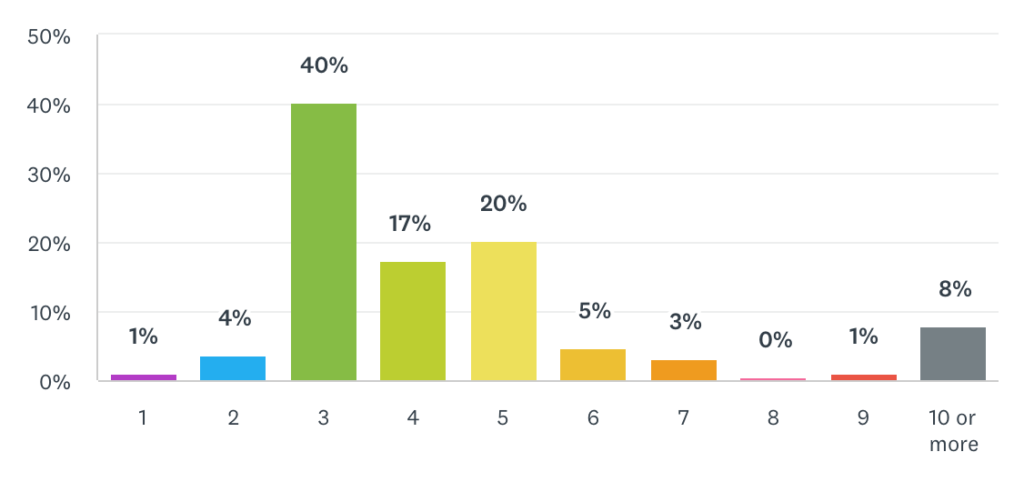
Thought-Provoking Takeaway 💡
In a world inundated with choices, nearly 8 out of 10 consumers engage with a moderate number of vendors (3-5) underscores the delicate balance between thorough research and analysis paralysis.
This result is consistent with a seminal study from 2000 by psychologists Sheena Iyengar and Mark Lepper. They discovered that consumers are more inclined to make a decision when given a smaller set of 6 options rather than a wider array of 24 options. This phenomenon is known as the paradox of choice.
As vendors compete for attention, they must ensure that the information they present is compelling and concise enough to stand out within this narrow evaluation window.
Actionable Takeaways 🎬
For businesses operating in a competitive marketplace, where their product or service is ranked, ranking in the top 5 is important given that consumers are likely to engage with a limited number of vendor profiles. Review generation should be considered a top priority for vendors outside of the top 5.
For review sites, continue to find more ways for buyers to filter their options to a manageable number (several, not dozens) and do so in a way tailored to the consumer.
In Summary
Online reviews continue to play a pivotal role in shaping consumer choices and preferences, revealing that most review site users find user-generated content more influential than vendor marketing and sales claims.
Most users deem the average rating on the 5-star scale crucial, reflecting the importance of numerical ratings in evaluating products and services. However, there is a prevailing concern among users regarding the authenticity of reviews, indicating a substantial distrust in the content found on review platforms.
Many users leverage review sites primarily as a tool for risk aversion, seeking to avoid subpar products or services. Ratings perceived as low are met with suspicion, showcasing a universal consumer expectation for a high-quality standard and satisfaction in products and services.
Typically, consumers consider multiple vendors on review sites before finalizing their purchasing decisions, emphasizing a balanced and comparative approach to buying.
In summary, the findings underscore the need for maintaining high levels of credibility and authenticity in online reviews to uphold consumer trust and confidence in the rapidly evolving digital marketplace.
Methodology
Data for the “2023 State of B2C Online Reviews” was sourced from an online survey.
In July 2023, via a SurveyMonkey audience, B2B SaaS Reviews surveyed US consumers aged 21-59 who have used one of these three online consumer review sites in the last 30 days: Angie’s List (Angi), ConsumerAffairs, and/or Yelp. We received 276 responses.
Respondents Overview
All 276 respondents are based in the US.
Here is a breakdown of their location by region:

Here is a breakdown of their household income:
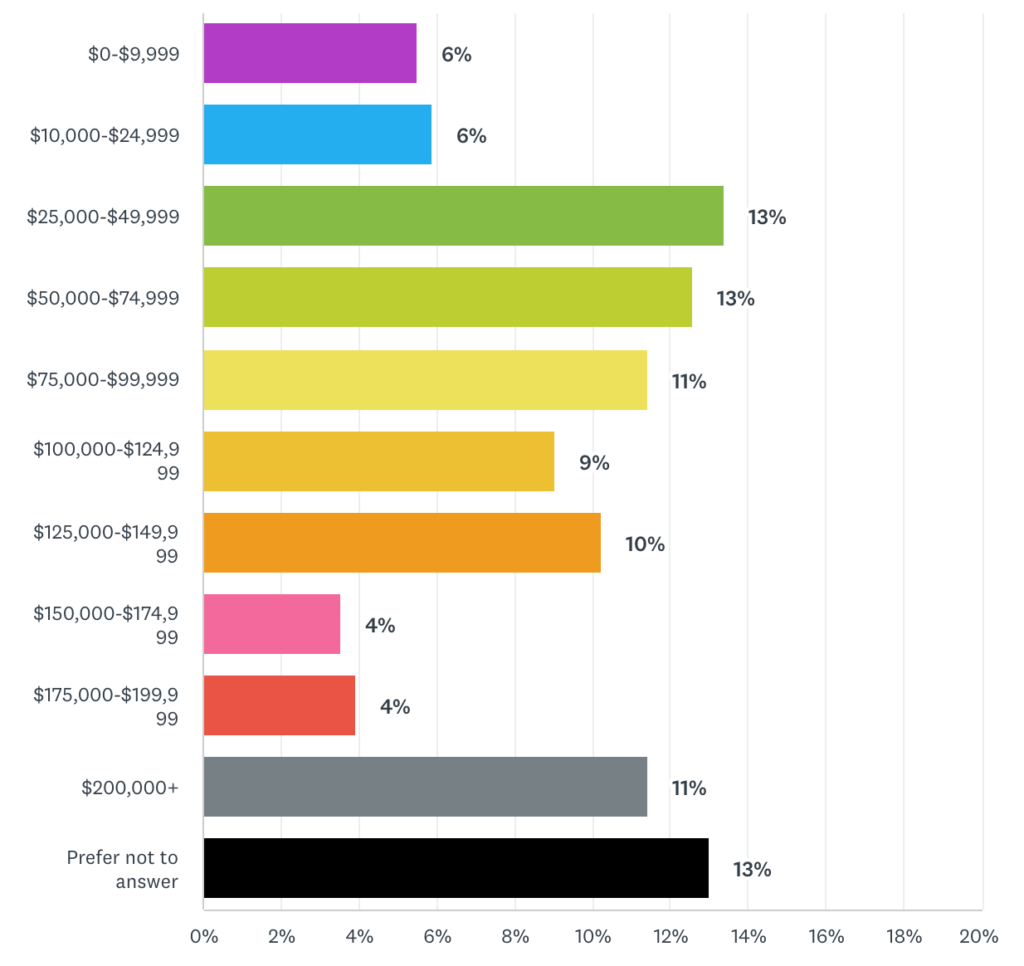
Here is a breakdown of their age:
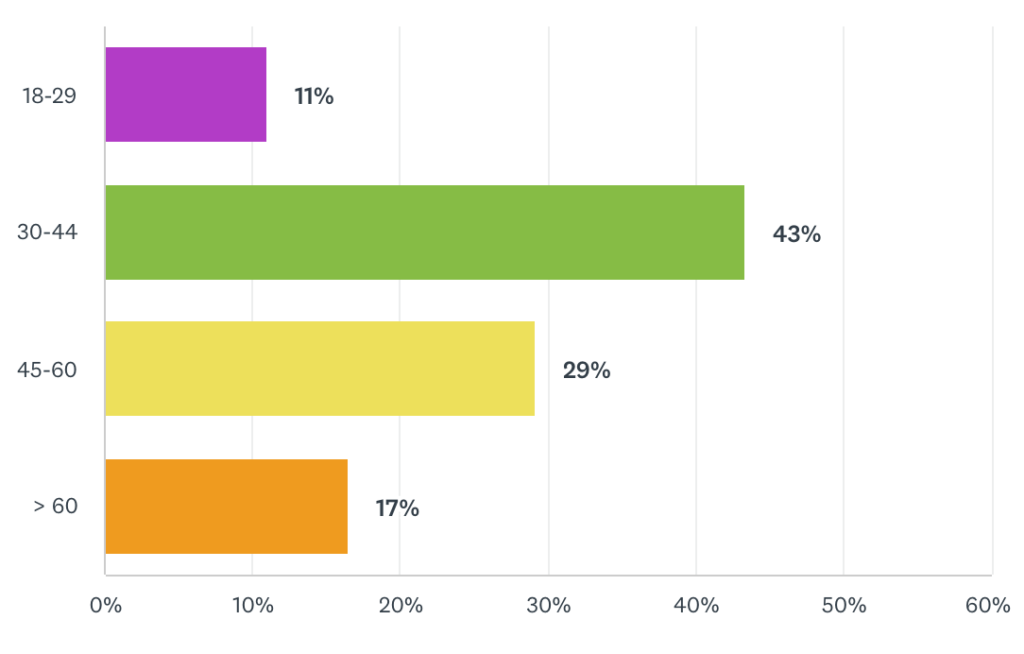
Looking for more stats on online reviews in B2B and B2C?
Author
-
I'm the Founder and Editor-In-Chief of B2B SaaS Reviews. I'm also the Director of Demand Generation at PartnerStack, the #1 platform purpose-built for partner management and affiliate marketing in B2B SaaS. Before PartnerStack, I worked for other go-to-market B2B SaaS companies: Influitive (Advocate Marketing designed to generate more reviews, references, and referrals), LevelJump (Sales Enablement) (acquired by Salesforce) and Eloqua (Marketing Automation) (acquired by Oracle).


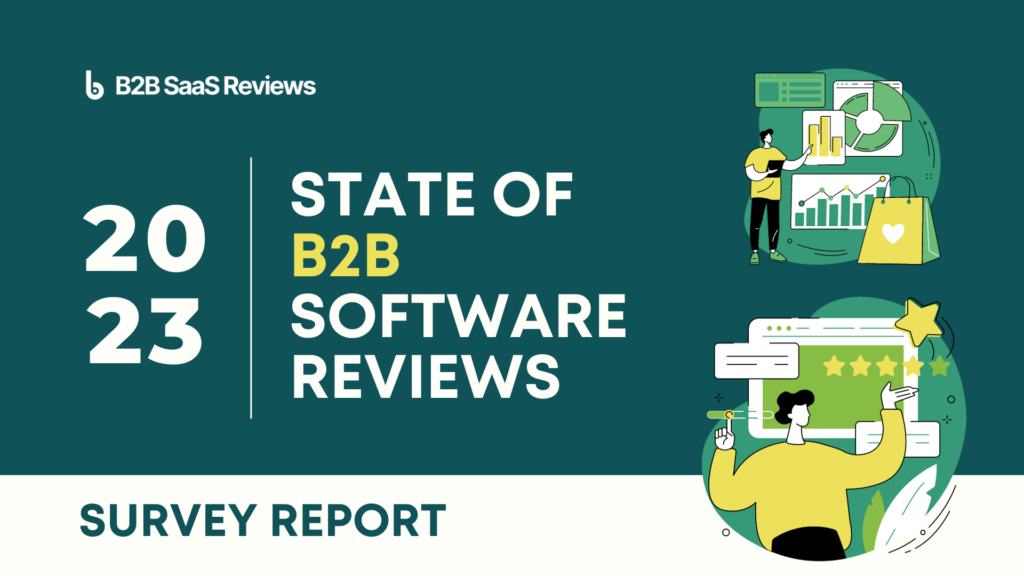
![63 Online Review Stats: B2B and B2C [2023]](https://b2bsaasreviews.com/wp-content/uploads/2023/10/banner-63-1024x574.png)

